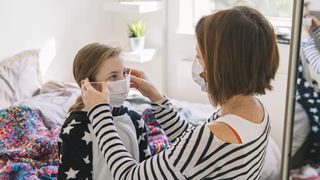That means that simply talking to a grocery store cashier could put you at risk of catching, or transmitting, the virus. Cloth face masks are not comparable to surgical masks, which ‘must continue to be reserved for healthcare workers and other medical first responders’. However, they create an important barrier when you do leave home and interact with others. Having a cloth face mask can act as an additional protective measure, but is not a substitute for social distancing guidelines. This advice applies to all except on young children younger than 2, anyone who has trouble breathing or is unable to remove the cover without assistance, who should refrain from wearing a homemade mask as a health precaution.
Which materials are most effective?
Research has shown (opens in new tab) that material with ‘a thread count of at least 180’ is thicker and denser, making it ideal for preventing particles from passing through when worn as a face mask. While popular substitutes for face masks, scarves and bandanas are some of the least effective materials tested. However, CDC guidelines suggest (opens in new tab) that using a coffee filter in combination with a bandana can be effective in protecting from the spread of particles. A good indicator of the density of your chosen material is to hold it up to the light, according to (opens in new tab) The New York Times. “If it’s a denser weave of thicker material and light doesn’t pass through it as much, that’s the material you want to use.”
How to make a face mask from home
CDC endorses the use of household materials to construct a face mask from home, and has released tutorials to make DIY face cloth coverings on its website (opens in new tab). If you’re planning on making a large amount of masks, you may need to use the best sewing machines (opens in new tab) to get the job done. It’s also worth checking out Michaels’ guide to DIY face mask projects (opens in new tab), as well as its elastic and material options. The full list of what you will need is as follows:
Two 10”x6” rectangles of cotton fabricTwo 6” pieces of elastic (or rubber bands, string, cloth strips, or hair ties)Needle and thread (or bobby pin)ScissorsSewing machine
There are loads of DIY face mask tutorials emerging online, but we like this short video from Melanie Ham, which shows you how to make an easy 10-minute face mask.






